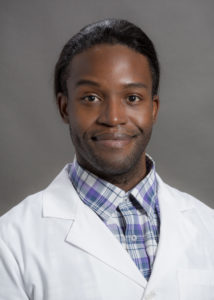Dr. Adlai Grayson presented research on diversity recruitment at two conferences
By Dr. Adlai Grayson, Interventional Radiology Resident
The Charles A. Rohrmann, Jr., MD, Endowment for Radiology Resident Educational Excellence fund has been pivotal in my development during 2024. Toward the end of spring, I received support to attend the AAR Annual Meeting, where I participated in a leadership program, contributed to organizing an event, and presented original research. In late autumn, I received additional support to attend the RSNA Annual Conference to present a different piece of original work.
AAR Annual Meeting
The Association of Academic Radiologists (AAR), formerly the Association of University Radiologists (AUR), comprises over 1,300 academic radiologists, residents, and fellows. The AUR encourages excellence in radiological laboratory and clinical investigation, teaching, and clinical practice. They stimulate an interest in academic radiology as a medical career, advance radiology as a medical science, and represent academic radiology nationally.
I participated in a variety of session types, from focused sessions on daily clinical practice to case-based discussions and video learning sessions. Each presentation was followed by a discussion period, allowing for interaction between researchers and attendees. The AAR Annual Meeting provided a dynamic venue for sharing ideas and exploring new collaboration opportunities with colleagues.
I presented research on diversity recruitment and retention in ACGME-accredited radiology residency programs. Besides delivering an oral presentation, I assisted in organizing parts of the event dedicated to physician wellness. This included setting up an art station in the lobby and organizing a talent show to encourage fun and creative expression. I also served as one of the masters of ceremony for the event, encouraging dozens of radiologists to dance along. Additionally, I participated in the AUR Radiology Resident Academic Leadership Development program. This program combined existing AUR sessions with specific content to enhance skills in leadership, teaching, networking, and workplace improvement, all valuable for a career in academics or leadership roles in private practice or industry.
RSNA Annual Conference
The Radiological Society of North America (RSNA) is a non-profit organization representing professionals from various radiologic subspecialties in more than 150 countries. The annual meeting is the world’s leading radiology forum, offering a robust research and education program, access to the latest medical imaging technologies, and numerous opportunities for professional engagement and career advancement.
This was the first time I attended the RSNA conference in person to present original research. Tens of thousands of attendees, including medical students, residents, and fellows, were present, providing opportunities to build relationships for future projects. While presenting research on proper follow-up in lung cancer screening, done in collaboration with a co-resident and passionate faculty mentors, I fielded questions from patient advocates and engineers. I reconnected with several mentors and mentees, reinvigorating my dedication to health equity and diversity in medicine. I also serendipitously ran into a friend from undergraduate school, now a Radiation Oncology attending, and several attendees recognized me from previous conferences.
In addition to attending sessions and presenting research, I assisted in organizing a workshop on managing contrast reactions for conference attendees from around the world. This included teaching the correct administration of epinephrine for allergic responses.
I attended these conferences to help the Department of Radiology achieve its goals of promoting innovation by providing research opportunities to train and educate residents. Our program molds trainees to become practitioners at the forefront of discovery, teaching, and organizational leadership. Seeing how many residents and fellows were sponsored and allowed to share their research was encouraging. Action items included presenting our data, engaging with colleagues, and inspiring continued investigation into ways to improve patient care.
Everything associated with these events motivated me to continue supporting the Department of Radiology in its pursuit of advancing UW’s drive for innovation and global engagement, as it is a proven benefit to any organization’s progress. I sincerely thank the Rohrmann Endowment Fund Education Endowment Advisory Committee for supporting my endeavors. I hope the committee sends a representative to demonstrate our program’s commitment to this cause in the future.